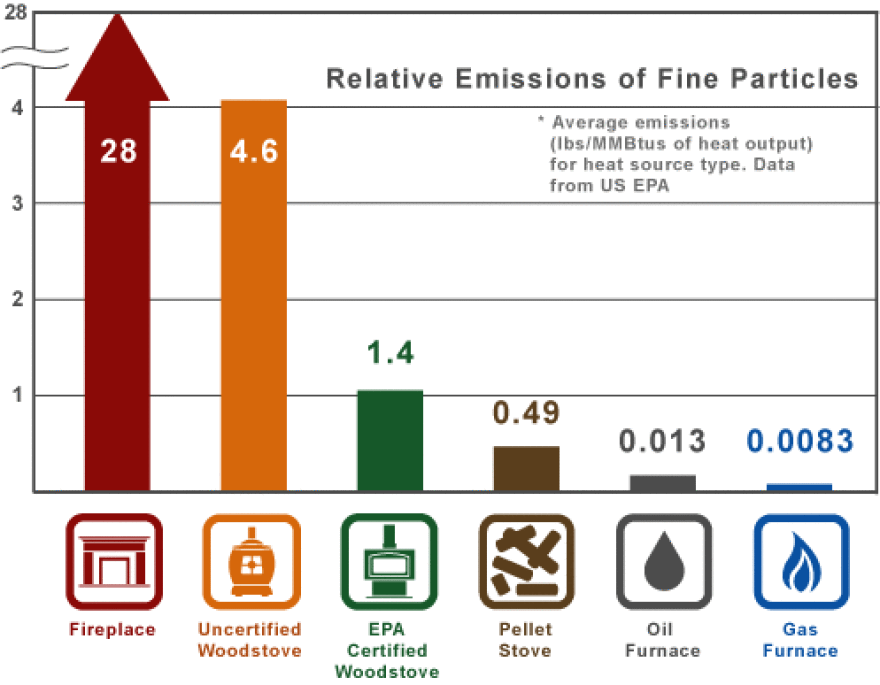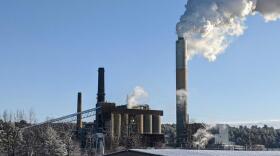A new EPA Clean Air standard for wood stoves is set to take effect next year.
It has been 25 years since the EPA wrote the first woodstove regulations. Since the rules were last refreshed, the health hazards from the unburned particles in wood smoke have been researched and quantified. But with the new rules now pending, manufacturers are saying that prices for new stoves will rise, and worry that will result in more people sticking with dirty old stoves.
Cheap, But Dirty
Chris Smith – the manager of Abundant Life, a hearth products seller in Chichester – is here to sell you a woodstove. Smith sells Pellet Stoves woodstoves in soapstone or cast-iron, but one thing that all his customers share is thrift.
“They’re always looking, they want the best deal for the buck,” Smith explains, “We have so many people coming in, you know they’re getting their oil prices in and it’s skyrocketed over the last couple years, and they’re looking for an alternative heat source.”
For most sales, it’s Yankee frugality that gets the customer through the door.
But here’s the rub.
“Its not to be taken lightly, even though most of us think of wood to be this warm, appealing way of getting heat in our homes, we need to recognize that wood has some serious health effects from the emissions,” councils Janice Nolan, an assistant Vice President with the American Lung Association.
Nolan says the science is piling up, showing that breathing in the little, unburned particulates in wood smoke, isn’t particularly good for you. “Particulate matter has recently been determined to be a cause of cancer. It also causes heart attacks and stroke, causes difficulty breathing, asthma attacks and early death,” she intones.
This led seven states, including all of the New England states except New Hampshire and Maine, to sue the EPA prodding them for a long-overdue update to their rules.

A draft of the new rule came out in January, and will become final next year. After five years, the pollution standard will get tighter.
On Pins and Needles
For woodstoves, the first step shouldn’t be hard to make. Stoves are already regulated: new ones burn between twice and fifteen times as cleanly as any stove built in the early eighties, and many already burn cleanly enough to meet the new standard until it ratchets up in 2020. A few, so-called hybrid stoves already could pass the 2020 standard.
But a whole class of wood-burners is still totally unregulated – wood boilers. You’ve seen the outdoor version of these in the yards of many rural homes, but there are indoor versions as well.
In Lyme, Tarm Biomass sells some of the cleanest wood-boilers on the market. Scott Nichols, shows off some boilers painted in a garish, bright red. The hunk of iron he points out first is pretty high-tech. It has sensors in the smoke stack, and it automatically adjusts air flow to make sure it’s re-burning as many of the particulates out of the smoke as possible.
But even so, standing in his showroom, he’s not sure it will pass.
“It might, it might but I’m doubtful,” he says, and then begins to gesture at the boilers that line the walls, “That one will not, and that one will not, so two-thirds of our boilers I think absolutely will not pass.” And any that do pass next year, he’s sure won’t pass five years later.
But he still approves of the push to clean these boilers up.
“I think the regulations are absolutely a good idea,” says Nichols, explaining that some of the cheaper, dirtier outdoor wood boilers send up big plumes of smoke, causing public battles between neighbors. It has given his industry a black eye.
“We can’t make our neighbors sick, while we greedily use cheap heat,” he says, “it’s just not a fair way to exist.”
But manufacturers are much less rosy.
They say proposed rule has stove and boiler builders on pins and needles as they see many unanswered questions. The EPA still hasn’t selected which test it will use to measure pollution, and hasn’t decided how long manufacturers will have to get compliant once the final rule is written.
“The rule is full of those things that as we read through them we were just flabbergast,” says John Crouch, head of public affairs for the National Hearth Patio and Barbeque Association.
"We can't make our neighbors sick, while we greedily use cheap heat."
There are somewhere between 6 and 9 million non-EPA certified stoves still in use today that have been chugging along since before 1988. On the flip side, people have only bought around 3 or 4 million certified ones.
Crouch says the industry believes a lot of work still needs to be done just to get people to replace their old woodstoves with ones that make the current standard, which are dramatically cleaner.
“So if we make new woodstoves more expensive five years from now, we can’t help but think that will slow that process down,” he says.
“The Cost of Business”
There are no solid numbers of how much more stoves will cost under the strictest proposed rule, but wood stove manufacturers throw around numbers of around 20 to 25 percent.
Chris Smith, the wood stove salesman, says he does occasionally get people in the door – usually they’re older – who suffer from a bit of sticker shock, already.
“You always have some customers that say, ‘well I don’t understand why they’re so much more than they used to be,’” but Smith says he educates, explains the new stoves burn more efficiently and can heat the same house with less wood, and generally folks come around.
“Pretty much everyone understands, it’s the cost of business,” he says.
And besides, woodstoves might be beside the point. Smith says these days, about 75 percent of his sales are pellet stoves, which already have higher price tags. A lot of customers like the convenience and cleanliness of pellets, compared to cord-wood.
And many pellet stoves already burn cleanly enough to pass whatever test the EPA chooses.









